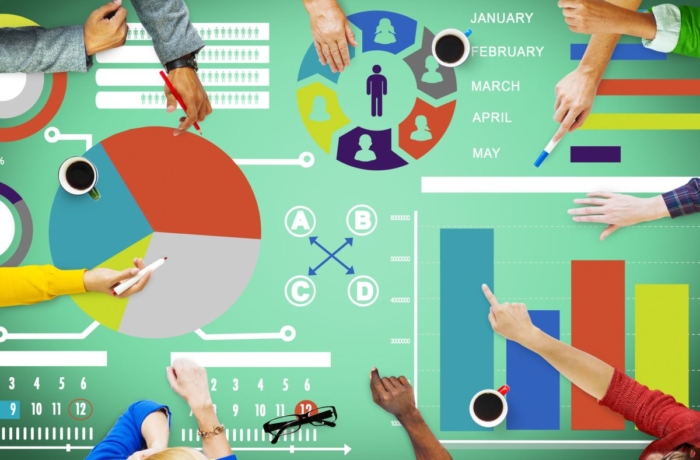Challenges in Taking Data in the Language Arts Classroom
We live in a time when information is on everyone's minds. Teachers, school administrators, and educational policy leaders are no exception.
Student data — family unit history, income level, attendance rates, ELL status, health information, and assessment performance — has the potential to improve didactics, if used properly. Teachers tin can use data to inform their classroom practices. Administrators can use data for school improvement. Boards of pedagogy (at state and federal levels) tin can utilise data to sympathise school and commune performance and to distribute funding.
The problem is that schools and teaching stakeholders have oft faced barriers to collecting data. In addition to day-to-day challenges, conversations about schoolhouse data are extremely complicated. Leaders know that information is an important tool, but they struggle to identify a articulate way to apply it at both micro and macro levels.
Barriers for collecting classroom data
Teachers and administrators alike face challenges when it comes to collecting data. Most of the barriers come downwards to two things: training and time.
Teachers are busy with lesson planning and educational activity, classroom management, grading, parent communication, and school meetings. Data drove frequently stays on the back burner, and teachers but attain out for student information in extreme cases.
Equally UCLA Graduate Schoolhouse of Education faculty advisor Rebecca Alber, Ed.D., writes at Edutopia, "it's difficult to find the time to read students' files, simply if you haven't before, trust me, information technology's well worth it." She reflects on a time when she chose to take the time to read files on students she was concerned nigh.
She discovered that one of her students was homeless, another had a mental disease, and others were placed in a general class even though they had been identified as gifted. Although the data was in their files, Alber simply learned about her students' histories when she personally took the fourth dimension to get through them.
Not all teachers are able to access this type of student data, nor do they take time to read through hundreds of educatee files. Teachers demand the support of their school administrators when it comes to having the data they need to improve their educational activity style, class management, and interventions with loftier-take a chance students.
Just administrators too struggle to find the time, preparation, and tools they need to collect and distribute student data.
In an ACT report that examined principals' use of data, research scientist Raeal Moore and statistician Teresa Shaw plant that principals report several different small-scale and major barriers to collecting student data. Minor barriers included
- A lack of preparation
- A lack of technical skills for using data
- Difficulties sharing and communicating nearly school information
Many schools simply don't know how to collect data and aren't prepared to utilize it effectively.
Principals say the largest challenge to collecting and using data is not having enough time. Teachers and schoolhouse staff are already overworked and don't feel similar there are plenty hours to devote to data collection, analysis, and implementation. Both principals and teachers need direction, grooming, and tools to assemble data and make data-informed decisions.

How to equip schools to gather different types of information
Before policy makers, administrators, and teachers start collecting data, they need to hold on what data they want to written report and why. At each level, data — not just test scores — will serve different purposes.
Teachers will want to know students' backgrounds and past academic history to guide their teaching. Administrators and policy makers will have to comply with country and federal regulations in order to improve school performance.
Jake Firman, manager of education technology at DSST Public Schools in Denver, says data shouldn't simply be used to measure out which students are succeeding or falling behind, but should be used as a way to measure the "civilisation" of schools and districts. This includes looking at things similar "particular pupil-instructor relationships that are struggling or excelling within the school, subtle shifts of a schoolhouse culture from positive to negative reinforcement, or early signs that a student is not buying into the values of the school community."
Every school, district, and country volition have dissimilar priorities, funding, and resource for conducting inquiry. The first footstep, though, is to agree on what is important to study and why. Merely then tin can they make up one's mind which tools volition aid them achieve their goals in an efficient manner.
Ane of the simplest tools teachers and administrators tin use is online forms. These forms can be integrated with tools to help leaders hands sympathise the information and to make data-informed decisions.
This data can be shared with other stakeholders after. Sharing important information is fundamental because no matter how much data collected, if it isn't shared with teachers, districts, and policy makers, it won't serve any purpose.
Instruction engineering writer Dian Schaffhauser says transparency and data sharing will be vital under the Every Pupil Succeeds Act. This is because while 48 states will be collecting new progress information, that data is largely undefined, and processes will exist unlike at land and district levels.
Data is only useful if it is clear why information technology is nerveless, how it was gathered, and if the people closest to students have access to information technology.
This article is originally published on May 31, 2019, and updated on Dec 08, 2021.
Source: https://www.jotform.com/blog/classroom-data-is-a-necessity/
0 Response to "Challenges in Taking Data in the Language Arts Classroom"
Publicar un comentario